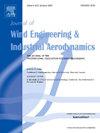A novel wind tunnel testing method for debris flight in turbulent winds
IF 4.9
2区 工程技术
Q1 ENGINEERING, CIVIL
Journal of Wind Engineering and Industrial Aerodynamics
Pub Date : 2025-07-22
DOI:10.1016/j.jweia.2025.106183
引用次数: 0
Abstract
Understanding the flight characteristics of windborne debris is crucial for risk mitigation. To physically capture the flight trajectories of small-size windborne debris (using, for example, high-speed cameras), boundary-layer wind tunnel tests need to be conducted at a relatively large geometric scale. However, under a large geometric scale the deficiencies in low-frequency turbulence are significant for conventional wind tunnels with passive turbulence generation. The low-frequency turbulence deficit can lead to a remarkable underestimation in the variation of debris flight trajectories, which compromises the scalability of wind tunnel tests. Although active devices can be used to physically introduce low-frequency turbulence, they are typically not accessible for many researchers and facilities. To this end, one alternative approach based on the “quasi-steady assumption” is introduced in this study to investigate debris flight in turbulent winds without active turbulence generation. In this “quasi-steady approach”, low-frequency turbulence is first considered by physically conducting conventional wind tunnel tests under multiple mean wind speeds and passively generated high-frequency turbulence. The results are then numerically post-processed according to the statistics of the full turbulence spectrum to correct the low-frequency deficit impact on debris flight. In this study, the proposed “quasi-steady approach” and baseline “unsteady approach” (with actively generated full-spectrum turbulence) are compared both numerically and experimentally. The results suggest good agreement of the two approaches, and potential factors accounting for the discrepancies are discussed to guide future investigations.
湍流中碎片飞行的一种新的风洞试验方法
了解风载碎片的飞行特性对降低风险至关重要。为了实际捕捉小尺寸风载碎片的飞行轨迹(例如使用高速摄像机),边界层风洞试验需要在相对较大的几何尺度上进行。然而,在大几何尺度下,传统的被动湍流产生风洞在低频湍流方面的不足是明显的。低频湍流赤字可能导致碎片飞行轨迹变化的显著低估,从而影响风洞试验的可扩展性。虽然有源装置可以用来物理地引入低频湍流,但对于许多研究人员和设施来说,它们通常是不可接近的。为此,本研究引入了一种基于“准稳态假设”的替代方法来研究没有主动湍流产生的湍流风中的碎片飞行。在这种“准稳态方法”中,首先通过在多个平均风速和被动产生的高频湍流下物理进行常规风洞试验来考虑低频湍流。然后根据全湍流谱统计对结果进行数值后处理,以修正低频赤字对碎片飞行的影响。在本研究中,提出的“准稳态方法”和基线“非定常方法”(主动产生全谱湍流)进行了数值和实验比较。结果表明,这两种方法有很好的一致性,并讨论了导致差异的潜在因素,以指导未来的研究。
本文章由计算机程序翻译,如有差异,请以英文原文为准。
求助全文
约1分钟内获得全文
求助全文
来源期刊
CiteScore
8.90
自引率
22.90%
发文量
306
审稿时长
4.4 months
期刊介绍:
The objective of the journal is to provide a means for the publication and interchange of information, on an international basis, on all those aspects of wind engineering that are included in the activities of the International Association for Wind Engineering http://www.iawe.org/. These are: social and economic impact of wind effects; wind characteristics and structure, local wind environments, wind loads and structural response, diffusion, pollutant dispersion and matter transport, wind effects on building heat loss and ventilation, wind effects on transport systems, aerodynamic aspects of wind energy generation, and codification of wind effects.
Papers on these subjects describing full-scale measurements, wind-tunnel simulation studies, computational or theoretical methods are published, as well as papers dealing with the development of techniques and apparatus for wind engineering experiments.

 求助内容:
求助内容: 应助结果提醒方式:
应助结果提醒方式:


